Research
Contact Us
RBS 2002
3900 University Blvd.
Tyler, TX 75799
Office Hours:
M-F 8 a.m. - 5 p.m.
800 UT TYLER
Ph: 903.566.7273
Fx: 903.566.7337
ce@uttyler.edu
Grade Reading and Activities Promoting Engineering
Research
Project Abstract:
GRAPE was a successful visitation program conducted by UT Tyler CE with Cain Elementary during the 2008-2009 academic year. Each visit noted in the table consisted of 2 university faculty members and several undergraduate volunteers coordinating hands-on engineering themed activities with two 5th grade classes.
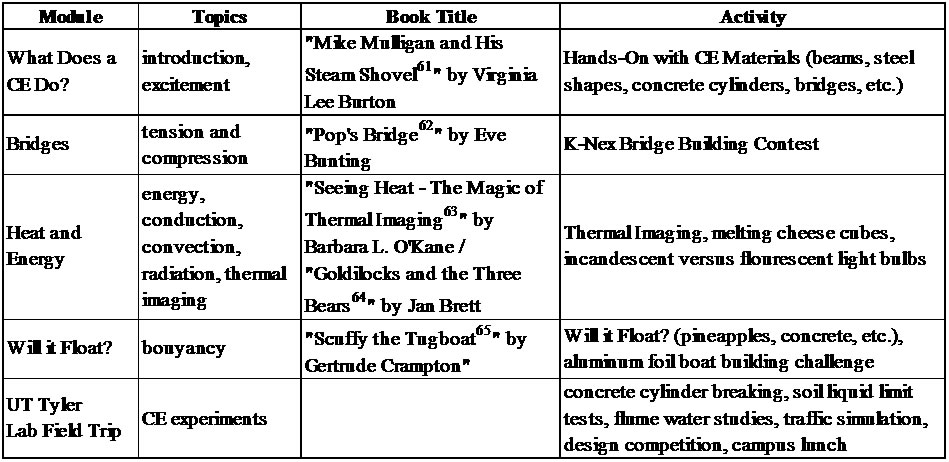
Pointing out the technical content hidden within well-loved stories during read-a-loud sessions illustrated to verbal learners that math and science concepts are everywhere and not intimidating. The visits were designed to tie-in with the 5th grade science and math curriculum that focuses on the physical world, and to build bridges between the 5th graders and potential undergraduate student role models. Female undergraduates were part of all visits to show girls that they could be vital members of the engineering community. The culmination of the program was a visit by these classes to the UT Tyler campus, where the students participated in hands-on experiments in CE laboratory spaces (e.g. concrete cylinder crushing, soil liquid limit testing, traffic congestion modeling and fluid dynamics studies in a flume chamber), a design competition, and then toured the UT Tyler campus on the way to an informal lunch in the University Student Center with undergraduate volunteers. The power of this activity to build enthusiasm for university study and engineering in particular were crystallized for the PI when he overheard a girl say to a female undergraduate volunteer at lunch "You are just like me...we like the same things!" Thus, we feel that we have really achieved one of the major objectives of the exercise: to inspire children to realize that math, science and engineering can be fun.
Introduction
The Cain Elementary School Reading Program is a project that is designed to get elementary school students (specifically 5th graders) EXCITED about engineering, math and science. Six times during the 2008-2009 elementary school academic year, we will visit Cain and facilitate an engineering themed activity. Each visit is targeted at two 5th grade classes simultaneously and lasts about an hour and 15 minutes. The basic framework of each activity centers around four sub-tasks: (a) A brief introduction that introduced the big ideas of the day's visit. Examples here include the difference between compression and tension, and the basic modes of heat transfer: convection, conduction and radiation. These remarks are always aimed at the 5th grade comprehension level; (b) A reading of a short engineering themed book. Examples of this include Mike Mulligan and His Steam Shovel by Virginia Lee Burton and Seeing Heat: The Magic of Thermal Imagery; (c) A focused hands on activity that allows the elementary students to apply some of the abstract concepts that we have introduced in the reading of the day in a concrete way. Examples of this include a K'Nex Bridge Building completion and demonstrations involving thermal imaging cameras, melting cheese cubes and energy saving light bulbs; (d) A concluding questions and answer wrap-up session where the children can ask questions that have been inspired by the day's activities. The interesting thing about these sessions is that we always get questions like "what is it like to be in college?, or "what do you do every day" that are not so much engineering based as they are rooted in the children's process of discovering what they want to be when they grow up.
Activities Organized by Date
First Visit: What Does a CE Do?
This visit was an introduction to what civil engineers do. We brought lots of physical
models (several K'nex bridges, light and heavy concrete cylinders, lots of rubber
shapes, several foam beams, asphalt cores, I-beam cross-section, etc.), wore our UT
Tyler hard hats and safety vests, and told the kids what civil engineers do in a very
exciting way. We finished the visit with a dramatic reading of Mike Mulligan and his
Steam Shovel, which includes building canals, roads, highways, airports and skyscrapers,
and also deals with issues of environmental impact, recycling and technology (among
others). We needed two faculty members and 4 student volunteers. It was nice to see
that the fifth grade classes were beginning their unit on earth science at this time,
so the physical nature of the civil engineering projects described here fit right
in. Figure 1 is a picture of one of our faculty members interacting with elementary
students and represents the activities that were performed on that day (although captured
at another, similar visit).
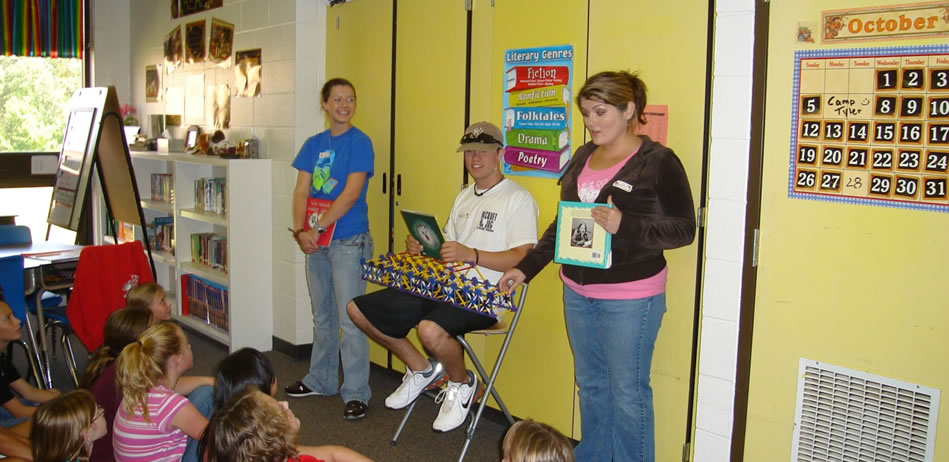
Discussing Civil Engineering
Second Visit: Bridges
We did a 5-10 minute slide show showing lots of different kinds of bridges (suspension, stringer, arch, steel, bamboo, timber, etc.). We had verified that the elementary school teacher had the correct projection equipment for this activity and it worked great. We also spent several minutes discussing the basic engineering design cycle with the kids, emphasizing the need to iterate, sometimes based on trial and error. The hands-on activity for this visit was a K'nex bridge building competition. The figure below shows the challenge sheet handed out to the kids.
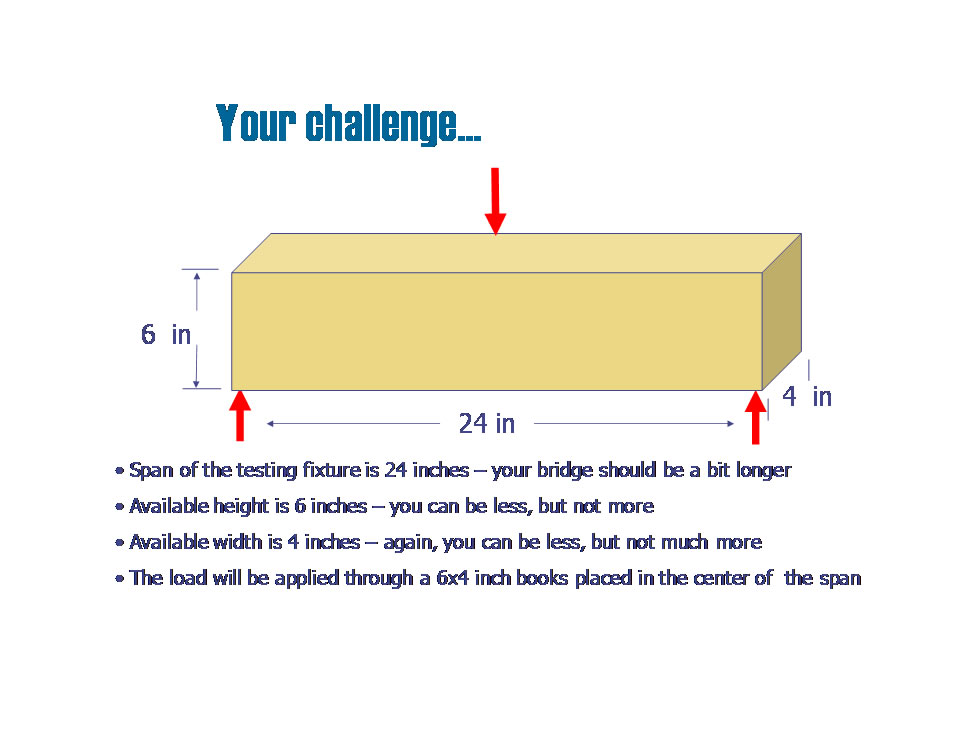
The children were divided into groups of 4 or 5 and although the groups needed some
help, we tried to let them creatively brainstorm their own ideas and learn by trial
and error. We brought enough K'Nex to ensure that each of the two classrooms had at
least 4 large toolboxes full. At the end of the build we tested each bridge in front
of all the students using steel manuals from our steel design class. The kids were
super excited and the winning bridge held up 9 steel manuals. We needed two faculty
members and 4students. It was coordinated so that his visit coincided with the 5th
grade unit that was beginning to discuss forces. The figure shows testing of one of
the bridges.
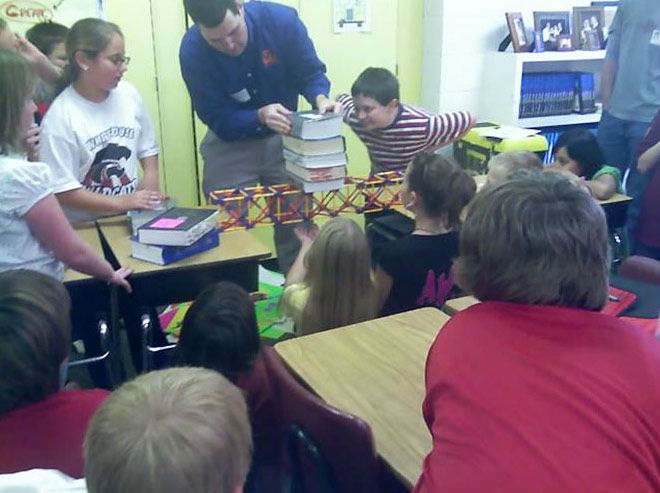
Testing Bridges (Note: Look at the excitement on the face of the child in the red
and white striped shirt. Do you think that he is having fun with math and science
here?
The next picture shows discussion of basic structural concepts.
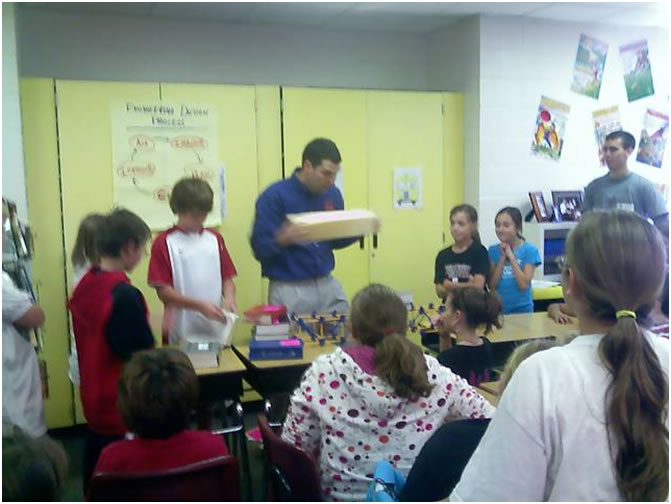
Discussing bending and torsion with foam models
Third Visit: Heat and Energy
The visit centered around activities with a laser thermometer and a thermal imaging camera. In one room we read Goldilocks and the three bears and then used a laser thermometer and bowls of 'porridge' to try to determine which of the three bowls was Mama's, Papa's and Baby's based on cooling rates. We had to introduce the kids to very simplified explanations of convection, radiation and conduction to do this. Dr. McGinnis helped put these activities together. In the second room we read Seeing Heat: The Magic of Thermal Imagery by Barbara L. O'Kane. This book describes thermal imaging cameras as a way to visualize heat, and shows lots of interesting pictures that illustrate these concepts. The Civil Engineering Department has a thermal imaging camera and we recreated some of the scenarios in the books such as allowing the kids to walk across the floor and then look at their own footprints in the camera, or see their handprints on the wall. We also brought a microwave and a hot-plate and melted cheese cubes of different sizes in them. We tried to explain the melting behavior for the children in terms of the convection, conduction and radiation concepts that we had introduced. Finally, we showed them the difference in heat output from regular (incandescent) light bulbs and energy saving (fluorescent) light bulbs and tried to introduce concepts about sustainability. This visit was great, the kids definitely learned something about heat and energy. We needed two faculty members and 6 students. We also convinced a mechanical engineering student to come and help us. Yay!
4th Visit: Will it Float?
This visit centered around activities designed to enhance understanding of buoyancy issues. After reading Scuffy the Tugboat in one room, the students were led through a quick discussion of buoyancy. It was important to relate these concepts to things that were already familiar to them – swimming in a pool, floating in a canoe, taking a bath, etc. Students were then given a series of random objects as shown in the picture below, and asked to decide whether they would float. Using an aquarium tank, the students were then allowed to come up and test their hypothesis. In the second room, the team modified the "Float My Boat" Activity set from the PBS series "Fetch with Ruff Ruffman," challenging the students to create aluminum foil boats. In contest form, the winning teams had to create an aluminum boat that would hold the most number of pennies without sinking.
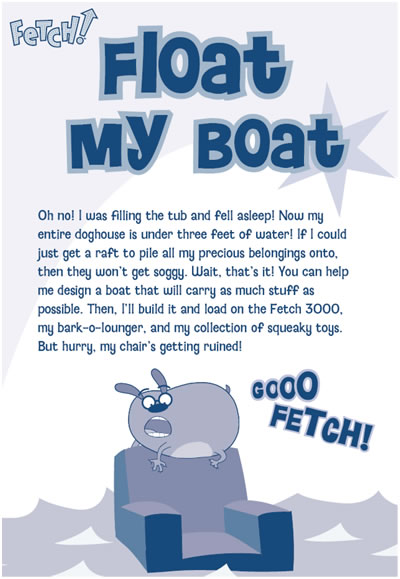
5th Visit – UT Tyler Lab Field Trip
For the 5th and final visit, a field trip of the two fifth grade classes to the UT Tyler campus was arranged. The students visited many of the civil engineering labs:
Structures Lab
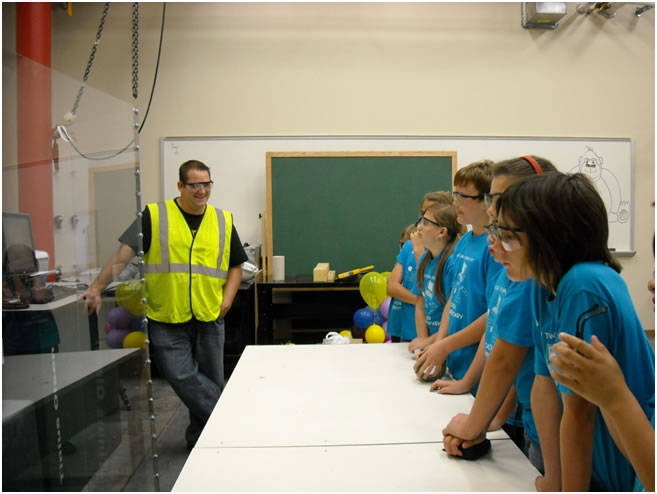
Getting ready for concrete to break
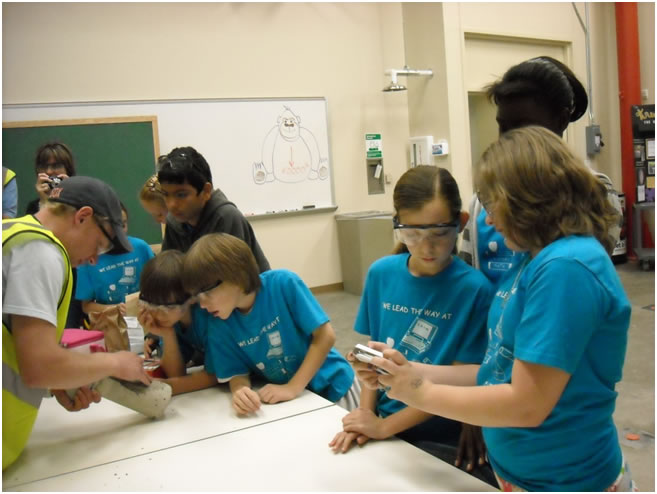
Examining the broken specimen
Hydrology Lab
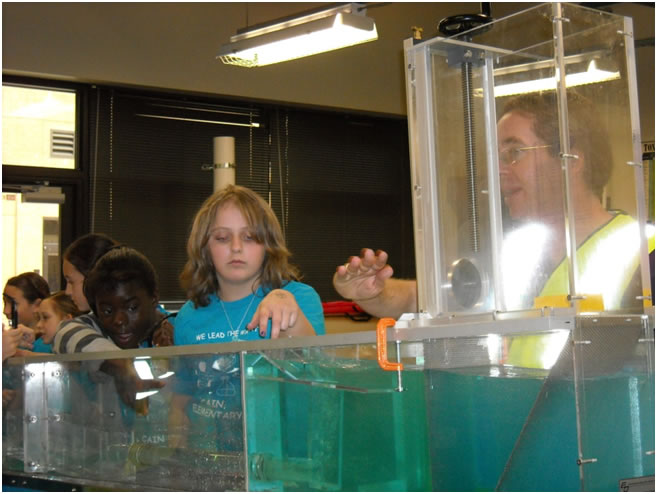
Discussing Hydraulic Jumps
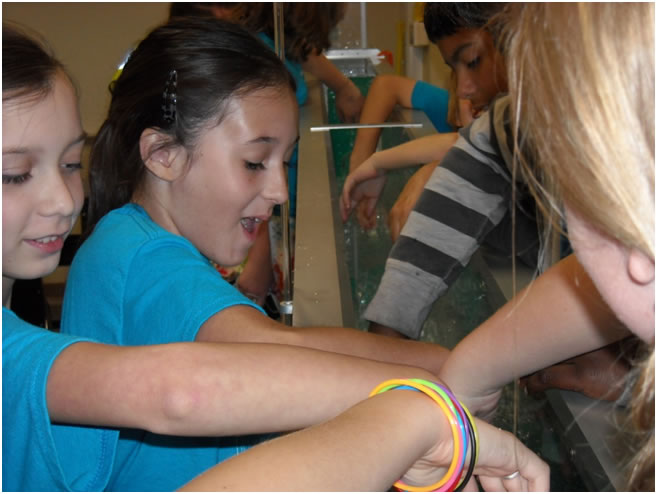
Can we touch it?
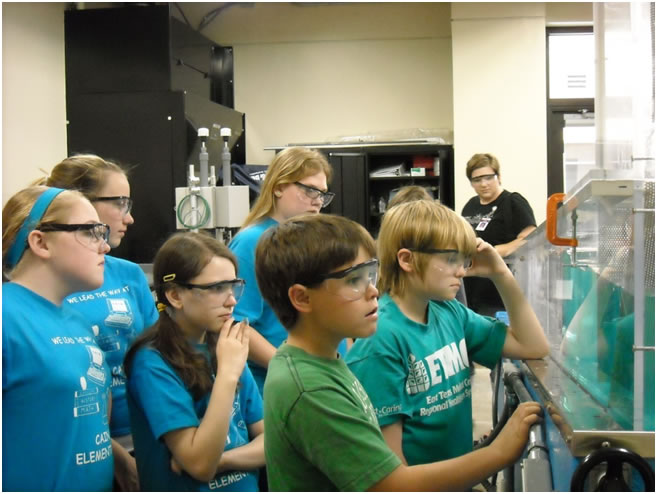
The Flume in Action
The Materials and Soils Lab
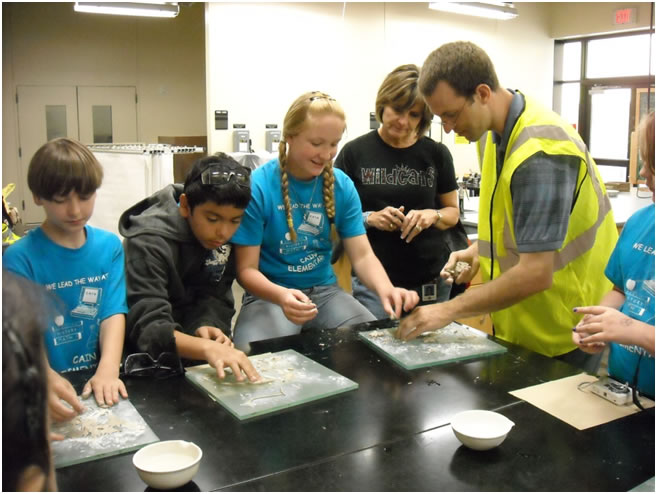
Liquid Limit Testing
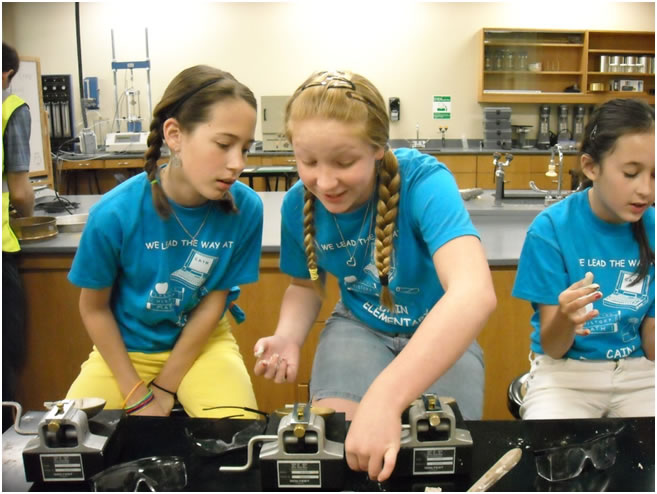
Is this working?
The Transportation Lab
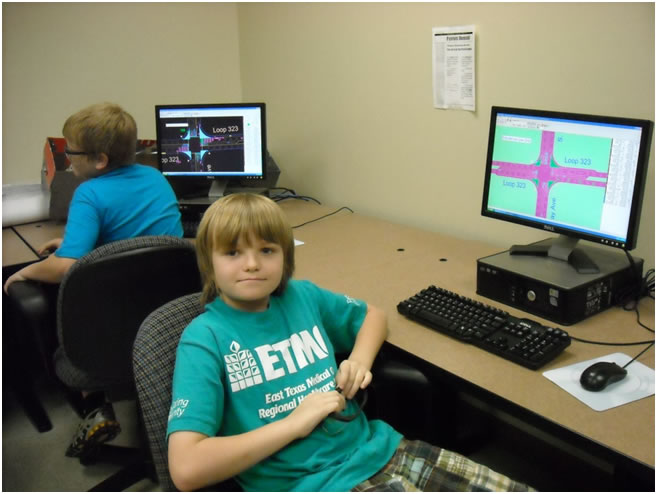
Modeling traffic problem on the Tyler loop
Contact Us
RBS 2002
3900 University Blvd.
Tyler, TX 75799
Office Hours:
M-F 8 a.m. - 5 p.m.
800 UT TYLER
Ph: 903.566.7273
Fx: 903.566.7337
ce@uttyler.edu